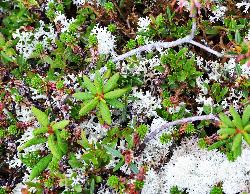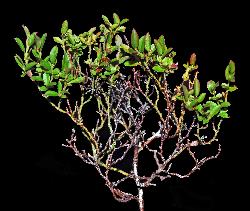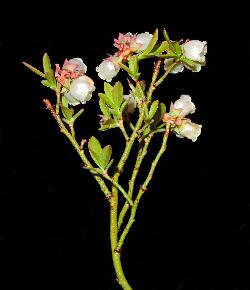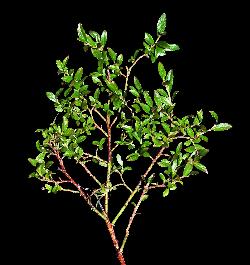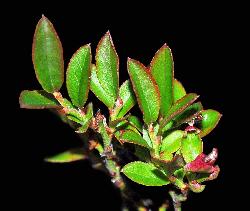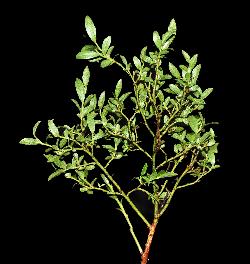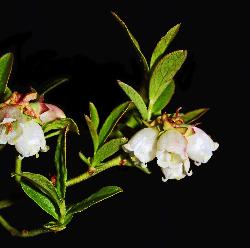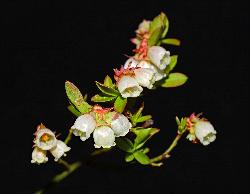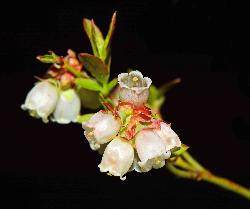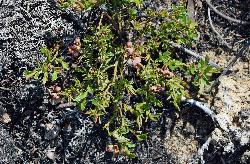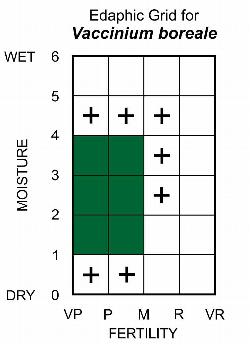Note: Numbers provided in square brackets in the text refer to the image presented above; image numbers are displayed to the lower left of each image.
General: A low decumbent deciduous shrub, 1–9 cm (usually 2–6 cm) tall, with superficial rhizomes, often forming dense colonies (Vander Kloet 1977). Northern blueberry is characteristic of exposed coastal headlands, alpine, and tundra habitats, as well as lichen woodlands on sandy soils [1]. Although an integral part of the Cladina lichen and moss carpets between barren hummocks on the Northern Peninsula and adjacent Labrador (Vander Kloet 1977), northern blueberry is easy to overlook in this habitat [2], as often only the upper leaves are visible in the dense barren vegetation, amongst Labrador tea, crowberry, bog laurel, and various lichens. Northern blueberry [3] looks like a dwarf version of lowbush blueberry (Vaccinium angustifolium Aiton), and was included within the species concept of V. angustifolium until 1961, when Hall and Aalders described this taxon as a distinct species (Hall and Aalders 1961). Northern and lowbush blueberries also differ in chromosome number; V. boreale is diploid (2n = 24), while V. angustifolium is tetraploid (2n = 48) (Vander Kloet 1977).
Key Features:
1. Leaves are alternate, narrowly elliptic to narrowly oblanceolate, usually less than 2 cm long by less than 6 mm wide, with finely serrate margins [4–5].
2. Flowers are borne in terminal racemes, corollas are white and urn-shaped (urceolate) [6].
Stems/twigs: Young twigs are slightly angled and green to red; the surface is finely warty (verrucose) and glabrous, except for 2 vertical lines of very fine recurved hairs that extend the length of the stems [6–7]. Mature stems have reddish-brown to dark brown bark. Flower buds, located at the stem tips, are ovoid, blunt (obtuse), and larger than the lateral vegetative buds; lateral buds are smaller, ovoid, and similar in colour to the flower buds. Leaf scars are small and narrowly hemispherical, with a single bundle trace scar.
Leaves: Alternate, simple, pinnately-veined, and short petiolate [7–10]. Leaf blades are narrowly elliptic to narrowly oblanceolate, yellowish-green to bright green, 0.8–2.1 cm long by 0.2–0.6 cm wide, glabrous on both surfaces, or rarely pubescent along the midvein below; the lower surface is slightly paler [11–12]. Leaf bases are narrowly tapering (attenuate) to rounded, the apex is sharply pointed (acuminate) to blunt (obtuse) or rounded, and margins are finely toothed (serrulate) with a small stipitate gland at the end of each tooth and scattered small incurved hairs. Like lowbush blueberry, early leaves of northern blueberry are reddish to bronze, and in autumn, leaves turn orange to red [13].
Flowers: Bisexual, in tight terminal inflorescences (racemes) at the branch tips, with flowers on short glabrous and glaucous pedicels [14–15]. The green calyx has 5 small triangular lobes, also glabrous and glaucous [16], and sometimes finely ciliate-margined. The corolla is white or greenish-white and tinged with pink, 3–4 mm long, and urceolate, with 5 short reflexed corolla lobes at the tip [17]. The 10 stamens have filaments that are ciliate near the anthers, which end in elongate tubular pores; the single pistil has an inferior ovary, a long slender style surrounded at the base by a nectar disk, and a small capitate stigma. Although no specific information on the pollination of northern blueberry was found in the literature, pollination of the flowers of other related Vaccinium species is primarily by bees (melittophily), and cross-pollination is necessary for good fruit set (Javorek et al. 2002, Usui et al. 2005). To collect pollen from blueberry flowers, visiting bees must vibrate the flowers in a specific way, causing pollen grains to travel through the tubular extensions of the anthers, then through the terminal pores. This process, called buzz pollination or sonication, is characteristic of larger solitary bees, e.g., bumble bees (Bombus spp.) and mining bees (Andrena spp.) (Buchmann 1983). Northern blueberry flowers bloom in mid to late spring, about 2 weeks earlier than lowbush blueberry plants (Vander Kloet 1977).
Fruit: In clusters of few to several small globose blue berries, 3–5 mm in diameter, usually with a pale glaucous bloom that rubs off easily [18–19]. The persistent calyx lobes form a small 5-pointed crown at the top of each berry. Northern blueberries are edible, with sweet flesh, and contain about 10–30 small seeds. Fruits mature in late summer to fall and are dispersed primarily by mammals and birds (endozoochory). As described under Vaccinium angustifolium, the fruit is technically a false berry, since the ovary is inferior and adnate to the hypanthium tube; true berries develop from superior ovaries.
Ecology and Habitat: Northern blueberry occurs in the forest-tundra, alpine meadows, and exposed coastal headlands of Newfoundland and Labrador, and occasionally occurs on open rocky uplands (Vander Kloet 1988) and lichen woodlands on sandy soils.
Edaphic Grid: See image [20]: the Edaphic Grid for Vaccinium boreale.
Forest Types: Northern blueberry has not been recorded in the forest classification of Newfoundland or Labrador, but has been observed growing in lichen woodlands in Labrador.
Succession: Because of its similarity to lowbush blueberry, northern blueberry has not been consistently separated as a species, especially in ecological studies. Where collected, it appears to have a distinct preference for open exposed habitats that have shallow snow cover. A specimen has been collected from a blueberry farm near Avondale (Vander Kloet 1977), so it appears to be as well adapted to fire as the lowbush blueberry.
Distribution: Northern blueberry is native to northeastern North America and is found throughout Newfoundland and Labrador, extending north to Hopedale (55° 30' N), west to northern Québec and the Gaspé Peninsula, and south to Cape Breton Isl., Nova Scotia. In the United States, northern blueberry occurs from Maine to northern New York State (Vander Kloet 1988).
Similar Species: Northern blueberry is most similar to lowbush blueberry (Vaccinium angustifolium Aiton), but lowbush blueberry can be recognized by its much taller size, 1–6 dm tall, larger leaves, 1.5–4.5 cm long, and larger berries, 6–15 mm long. Velvetleaf blueberry (Vaccinium myrtilloides Michx.) is similar in size and appearance to lowbush blueberry, but has velvety-pubescent stems and leaves



